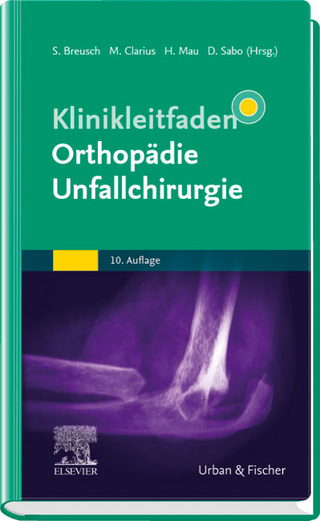
Cervical Spine I
Springer Wien (Verlag)
978-3-7091-8884-2 (ISBN)
1. Biodynamics of the Cervical Spine.- 1.1. Anatomo-Clinical Correlations in Cervical Spondylosis.- 1.2. Stability and Instability of the Cervical Spine.- 1.3. Biodynamics of the Lower Cervical Spine.- 1.4. Kinematic Study of the Inferior Cervical Spine in Sagittal Plane.- 1.5. Instability in Cervical Arthrosis.- 1.6. Lower Cervical Spine: Biomechanical and Clinical Combined Approach.- 1.7. Cervical Facetectomy and Its Effect on Stability.- 1.8. Forces and Motions Across the Neck in Patients Treated with Halovest for Unstable Cervical Spine Fractures.- 1.9. Stability of the Lower Cervical Spine.- 1.10. Comparative Stability of Anterior or Posterior Cervical Spine Fixation-in vitro Investigation.- 1.11. The Part of the Macromolecules of the Extracellular Matrix in the Biomechanics of the Lower Cervical Spine.- 1.12. Chronic Atlanto-axial Instability in the Down Syndrome.- 2. Diagnostic Evaluation.- 2.1. Initial Sensory Examination as a Predictor of Neurologic Recovery Following Anterior Spinal Cord Injury.- 2.2. Sectorization of the Axial Image of Cervical Vertebrae, a Heuristic Approach for Automatic Analysis in Artificial Intelligence.- 2.3. Unstable Cervical Trauma and Traumatic Conditions Inducing Neurological Complications as Investigated by CT-Scanning.- 2.4. CT Diagnosis of Cervical Hernias.- 2.5. Magnetic Resonance Imaging of the Cervical Spine and Spinal Cord.- 2.6. Osteo-vascular Correlations on Cervical Spine Diseases.- 2.7. Acute Cervical Myelopathy C5-C6.- 2.8. Magnetic Resonance Imaging of Cervical Spinal Stenosis.- 2.9. Developments in the Diagnosis of Cervical Hernias Using the Scanner.- 2.10. CT Evaluation of the Multiple Subtotal Somatectomy Results.- 2.11. Temporal Alterations in Somatosensory Evoked Potentials in Cervical Spondylotic Myelopathy.-2.12. Calcic Densities in the Cervico-occipital Joint.- 2.13. Importance of CT in Fractures of the Cervical Articular Pillar.- 2.14. Relationship Between Osteophyts and Symptoms in the Cervical Spondylosis.- 2.15. Relationship Between Clinical Results and CT After Cervical Spinal Canal Laminoplasty.- 2.16. Spondylolysis of the Cervical Spine.- 3. Traumatic Instability and Management.- 3.1. Treatment of Cervical Spine Injuries by a Posterior Osteosynthesis with Plates and Screws.- 3.2. Double Hole Plate Fixation of the Lower Cervical Spine.- 3.3. Unstable Injuries of the Lower Cervical Spine.- 3.4. Treatment of Unstable Cervical Spine Injuries with Halo Vest.- 3.5. Anatomo-pathological Study of Cervical Spine Trauma. Treatment and Results.- 3.6. Functional Results of Anterior Interbody Fusion in Injuries to the Lower Cervical Spine.- 3.7. Anterior Stabilization with the Trapezial Osteosynthetic Plate Technique in Cervical Spine Injuries.- 3.8. Anterior Cervical Fusion-Indications and Results.- 3.9. Incomplete Dislocations of the Lower Cervical Spine with Unilateral Articular Fracture-the Value of Arthrodesis by Anterior Operative Approach.- 3.10. Stable Dorsal Fusion of the Cervical Spine (C2-Th 1) Using Hook Plates.- 3.11. Traumatic Quadriplegia in Cervical Spine Stenosis.- 3.12. Fracture Separation of the Articular Process of the Inferior Cervical Vertebra: a Comprehensive Review of 13 Cases.- 3.13. Traumatic Spondylolisthesis of the Axis.- 3.14. Dens Fractures: a Multi-Center Study.- 3.15. Dens Transfixation Plate.- 3.16. Traumatic Lesions of the Upper Cervical Spine.- 3.17. A Combined Fracture of the Anterior and Posterior Arch of the Atlas Due to Extreme Lateral Bending: Case Report.- 4. Degenerative Lesions and Management.- 4.1. Hydroxylapatite Graft Materialsfor Cervical Spine Fusions.- 4.2. A Simultaneous Combined Anterior and Posterior Approach to the Cervical Spine for the Resection of an Osteoblastoma.- 4.3. Rheumatoid Spondylarthritis of the Cervical Spine.- 4.4. Anterior Interbody Fusion with Transdiscal Decompression in the Cervical Spin.- 4.5. Cervical Spondylotic Myelopathy: The Results of Anterior Decompression and Stabilization.- 4.6. Extensive Posterior Fusion for Cervical Spondylotic Myelopathy.- 4.7. Experiences With the Antero-medial Microsurgical Cervical Osteophyte Removal Without Interbody Fusion.- 4.8. Reoperative Cases After Anterior Spinal Decompressive Surgery for Cervical Spondylotic Myelopathy.- 4.9. Combined Anterolateral and Anteromedial Approaches of the Lower Cervical Spine.- 4.10. Transdiscal Osteophytectomy and Fusion According to Robinson's Method.- 4.11. Halo Vest Indications.- 4.12. Freeing of the Vertebral Artery by Uncusectomy of Jung.- 4.13. An Isolated Congenital Narrow Canal of the Atlas.- 4.14. Stable Posterior Fusion of the Atlas and Axis by Transarticular Screw Fixation.- 4.15. Mandibular Splitting Approach to the Upper Anterior Vertebral Canal.
| Erscheint lt. Verlag | 10.1.2012 |
|---|---|
| Zusatzinfo | XVI, 333 p. |
| Verlagsort | Vienna |
| Sprache | englisch |
| Maße | 170 x 244 mm |
| Gewicht | 607 g |
| Themenwelt | Medizinische Fachgebiete ► Chirurgie ► Unfallchirurgie / Orthopädie |
| Schlagworte | spine • trauma surgery |
| ISBN-10 | 3-7091-8884-9 / 3709188849 |
| ISBN-13 | 978-3-7091-8884-2 / 9783709188842 |
| Zustand | Neuware |
| Informationen gemäß Produktsicherheitsverordnung (GPSR) | |
| Haben Sie eine Frage zum Produkt? |
aus dem Bereich


